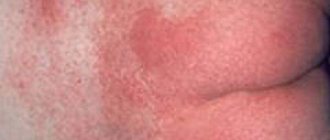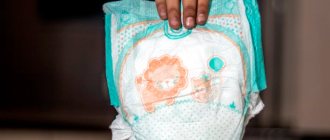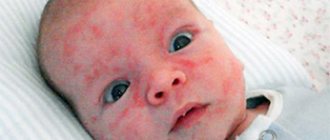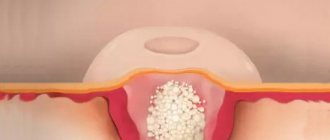General information
Diaper dermatitis (syn. diaper dermatitis, diaper rash in newborns, diaper rash) in pediatric practice is one of the most common skin lesions in children of the first year of life. Diaper dermatitis was first described more than 100 years ago, and the term “diaper dermatitis” first appeared in the early 1960s, coinciding with the introduction of the production/use of disposable diapers. Diaper dermatitis (ND) is an inflammatory reaction of the baby's skin in the area of contact with the diaper/diaper, manifested in the form of irritation, redness, rashes or swelling of the skin. The photo below shows what diaper dermatitis looks like.
In the outpatient practice of a dermatologist, the incidence of the disease in the population of infants is on average 15%, debuting in the age interval of 3-12 weeks with a peak incidence at the age of 6-12 months. At the same time, the disease is more often diagnosed in girls. The incidence of diaper dermatitis among newborns who are breastfed is lower, which is due to the lower enzymatic activity of their feces/urine. Children with a tendency to allergic reactions, those receiving artificial feeding, and those who have undergone a long course of antibiotic therapy are more likely to suffer.
The disease occurs much less frequently after 3 years of age, which is due to the “maturation” of the protective functions of the skin and the child’s acquisition of hygienic skills. Diaper dermatitis in older children occurs mainly in those who need to wear diapers for a long time (with urinary/fecal incontinence).
The development of the disease is largely facilitated by the peculiarities of the skin in infants/young children, which functions in a state of unstable equilibrium and cannot fully perform a protective function. The main ones are:
- immaturity of the skin (fragility of the basement membrane, thinness/vulnerability of the epidermis, underdevelopment of the connective component of the dermis);
- reduced skin hydration (relatively low moisture content);
- high skin pH in skin folds;
- imperfect immune/thermoregulatory function;
- tendency to be easily injured.
In addition, reduced humoral/cellular immunity in the early periods of life and an insufficiently formed water-lipid mantle on the surface of the skin of newborns/increased alkalinity of the skin, in particular in intertrigenous areas, contribute to an increased susceptibility of the skin to infection by microorganisms that easily penetrate the damaged epidermal barrier. Also, the cause of prolonged inflammation, accompanied by excoriations , severe itching and the addition of a secondary infection, are metabolic disorders.
Diaper dermatitis in a newborn is provoked by a lack of skin breathing (greenhouse effect), wet diapers, irregular/improper hygiene procedures, and infrequent washing of diapers. The severity of the disease can vary widely: from local, mild irritation from diapers to deep/extensive infection of the skin.
Despite the good study of the ethology/pathogenesis of the rash in the diaper area, as well as the factors contributing to its development, the problem is still relevant and common in children of the first year of life.
Treatment of skin lesions with diaper dermatitis
Despite the general availability of almost any information on the topic of childhood diseases, we want to warn parents against trying to self-medicate! The health of your baby, especially at such a “tender” age, is an extremely fragile thing. And you can only entrust it to a qualified, knowledgeable specialist. Therefore, like any other childhood disease, diaper dermatitis in children can only be diagnosed and treated by a doctor! However, we will be happy to share with you several techniques that will help alleviate the baby’s condition before the pediatrician arrives. So, first of all you need to:
- minimize contact of the baby’s skin surface with a wet diaper or diaper;
- regularly wash the child with warm water and baby soap;
- organize air baths.
If the doctor also discovers a secondary infection that aggravates the course of childhood dermatitis, then it is necessary to carry out a set of measures to treat this infection and its consequences.
Pathogenesis
The pathogenesis of the disease is a cyclical process, at the beginning of which there are factors that have a damaging effect on the skin: physical (friction / high humidity), chemical (urea breakdown products / enzymes of feces and bacteria), and biological (microbial) factors. As a rule, the pathological process is triggered by an increase in skin moisture, which is caused by prolonged/frequent contact of the skin with wet diapers/diapers. This is accompanied by an increase in the coefficient of friction, which contributes to its mechanical damage.
Against this background, skin permeability increases and sensitivity to chemical and microbial damaging factors increases sharply, among which lipase / protease (stool enzymes) play a special role. Their adverse effects on the skin are caused by the loosening of all layers of the epidermis and connective tissue matrix and, as a consequence, an increase in the permeability of the dermis. The adverse effect of fecal enzymes increases significantly when they are combined with urine, from which ammonia urease , synthesized by fecal microbes . In turn, an increase in ammonia concentration increases skin pH and activates protease/lipase and increases the toxic effect on the skin, leading to accelerated destruction of the epidermal barrier
Insufficient/defective care of the baby's skin and the lack of air circulation under the diaper, creating a sealed environment, contributes to maceration of the skin and the rapid penetration of irritants and microorganisms into and through the epidermis. Factors contributing to the development of diaper dermatitis are schematically shown below.
Also, an increase in humidity and pH of the skin contributes to the increased reproduction on the surface of the skin of microorganisms of the genus Candida albicans, gram-positive/gram-negative flora (Proteus/Pseudomonas aeruginosa), that is, the inflammatory process “under the diaper” can be enhanced by an infectious component, which affects clinical manifestations and the degree of their severity .
DIAPER DERMATITIS
The issues of caring for the skin of a child in the first years of life remain relevant to this day. Due to the anatomical and physiological characteristics of children (thin and sensitive surface layer of the epidermis, well-developed capillary network, lack of local immunity), the protective function of the skin, protecting against adverse external influences, is significantly reduced in them. At the same time, the resorption and respiratory functions of the skin are increased.
The influence of various damaging factors, improper use of care products: creams, powders, soaps, as well as diapers - all this can lead to disruption of the normal condition of the skin [1, 4].
One of the most common skin changes is diaper dermatitis, the incidence of which ranges from 35 to 50% [3]. It is observed more often in girls. Children with increased sensitivity to allergens are more predisposed to diaper dermatitis, which is explained by the development of exudative phenomena and dyspepsia. Breastfed children are less likely to suffer from diaper dermatitis, since their feces have low enzymatic activity.
The first attempt to establish the etiological factor of diaper dermatitis was made by Zahorsky in 1915. Studying case histories, he drew attention to the frequent combination of two factors - “ammonia diapers” and diaper dermatitis. This led to the conclusion that ammonia may cause skin irritation. In the early 80s. Over the past century, a number of studies have been conducted to identify the etiology of diaper dermatitis. Currently, diaper dermatitis is defined as a periodically manifested pathological process that occurs due to the effects on the child’s skin of mechanical (diaper fabric), physical (humidity and temperature), chemical (ammonia, digestive enzymes, bile salts), microbial factors that do not only irritating, but also toxic to the child’s highly sensitive skin.
Research has shown that diaper dermatitis is a complex cyclic process involving three stages [2].
The first stage is initially damaged skin. The development cycle of diaper dermatitis begins from the moment when the protective function of the stratum corneum of the epidermis of healthy skin decreases. This can happen for a number of reasons.
- High humidity. Urine wets the skin. Wet skin is easily damaged by friction, which in turn allows irritants to penetrate.
- Action of fecal enzymes. Protease and lipase, which are normally present in children's feces, have an irritating effect on the skin, increasing its permeability.
- Interaction of urine and feces. Urease, produced by fecal bacteria, reacts with urea in urine, releasing ammonia. Ammonia increases the pH of the environment, resulting in increased activity of the main irritating factors (protease and fecal lipase) and increased skin permeability.
These factors lead to damage to the skin.
The second stage is diaper dermatitis. The factors listed below, acting individually and in combination with each other, cause diaper dermatitis.
- Mechanical irritation. Rubbing skin against each other or against the diaper can cause chafing.
- Chemical and biological irritation. Fecal protease and lipase, ammonia and bile salts may increase skin irritation.
- Infectious agents. Microorganisms found in feces, especially Candida albicans, can infect weakened skin. The most prolonged and severe diaper dermatitis is caused by exposure to microorganisms.
The third stage is recovery (normalization of the condition of the skin). Having gone through its development cycle, uncomplicated diaper dermatitis is eliminated in two to three days, and patient care is of no small importance.
Depending on the severity, there are 3 successively developing stages of diaper dermatitis (criteria F. Germozo, 1984). A mild degree is manifested by redness, a mild papular rash and peeling of the epidermis in the genital area, buttocks, lower abdomen and lower back. The average degree develops if the impact of irritating factors is not eliminated. Papules, pustules, erosions appear on the skin, infiltrates can form in the skin folds, and infection with bacteria and Candida albicans is possible. With a prolonged course of the disease (severe degree), extensive infiltrates, papules, blisters, oozing, deep erosions, and ulcerations are formed. The affected area increases.
The main goal of skin care for a young child is to prevent irritation and damage to the epidermis. This is achieved by cleansing the skin, protecting it from adverse effects, in particular contact with secretions.
The delicate and sensitive skin of a child requires gentle but regular and thorough cleansing, especially in the anus and genital area. To do this, use gentle detergents. The skin has a lower threshold for irritability, so these products should not be used in excess. It is believed that soap can irritate the skin due to alkaline components, and synthetic detergents (bath bubbles, shampoos) due to the degreasing effect they produce. You should bathe your child using detergents no more than 2-3 times a week, while washing should be done regularly, and after bowel movements, it is mandatory. Dry the skin using towels or diapers made of soft cotton fabric using blotting movements.
In addition to cleansing, the skin must be powdered or lubricated with creams and oils. Moderate powdering of the skin protects it from diaper chafing, while excessive powdering, especially after bathing if the skin is not wiped dry, leads to crusting and crumbs. Some children do not tolerate rubbing emollients into the skin well, since this manipulation can be accompanied by delayed sweating and maceration. Excessive use of oils impedes the respiratory function of the skin. Thus, cosmetic skin care products must be selected individually for each child, using domestic and foreign products, moisturizing oil, baby cosmetic milk, toilet soap, baby powder, etc.).
To prevent skin contact with secretions (urine and feces), it is advisable to use modern disposable diapers, the inner cellulose layer of which contains a gel-forming material with high moisture absorption capacity.
When the first clinical symptoms of diaper dermatitis appear, it is recommended to stop using cloth diapers and oilcloths and switch to disposable diapers, which must be changed every 3-4 hours, even at night. The advantage of these diapers is that urine is absorbed and retained in the inner layer, without the baby's skin coming into contact with the moisture. In addition, feces do not mix with urine; the stool is contained by the diaper. This eliminates one of the main pathogenetic mechanisms for the development of diaper dermatitis. In addition, the child should not be dressed too warmly; tight-fitting clothing should also not be used.
For diaper dermatitis, the use of creams and ointments is recommended to treat the affected areas of the skin. Desitin ointment containing zinc oxide has a tightening effect, resulting in a decrease in the flow of mucus and other secretions to the affected areas of the skin. In addition, a protective barrier is created against irritating factors.
The components of the cream "Drapolen" - benzalkonium chloride and citrimide - have a local antiseptic and disinfectant effect. White soft paraffin, anhydrous lanolin and cetyl alcohol included in the cream have a softening, protective and hydrating effect.
Ointments "d-Panthenol" and "Bepanten", containing dexapanthenol, stimulate epithelization of the skin, and in addition, have an anti-inflammatory effect.
The drug used should be applied daily in a thin layer to the affected areas of the baby's skin during swaddling until the symptoms of diaper dermatitis disappear.
Research conducted at the Clinic of Children's Diseases of the MMA named after. I.M. Sechenov, showed that Drapolen cream is advisable to use for the treatment of mild forms of diaper dermatitis, as well as for the purpose of preventing its development. D-Panthenol ointment is effective in the treatment of mild to moderate diaper dermatitis.
Treatment of infection caused by Candida albicans is carried out by eliminating candidiasis of the oral cavity and intestines (Diflucan is used once a day at a rate of 2-5 mg/kg for 5-7 days). Creams or powders with antifungal drugs (miconazole, clotrimazole, ketoconazole, batrafen) are applied topically. If itching is present, antihistamines are used.
Literature
- Yatsyk G.V., Stepanov A.A. Use of d-Panthenol ointment in children of the first year of life // Issues of modern pediatrics. - 2002. - T. 1. - No. 2. — P. 90-92.
- Berg RW Etiologic factors in diaper dermatitis: A model for development of improved diapers. Pediatrician. 1986. - Vol. 14. - No. 1. — P. 27 — 33.
- Jordan WE, Lawson K., Berg R., Fromxman J. Diaper dermatitis: frequency and severity among a general infant population, Pediatr. Dermatolog. 1986. - Vol. 3. - P. 198 - 207.
- Liou LW, Janniger CK Skin care of the normal newborn. Cutis. 1997. - Vol. 59. - No. 4. - P. 171 - 174.
N. A. Geppe, Doctor of Medical Sciences, Professor N. A. Belousova, Candidate of Medical Sciences MMA named after. I. M. Sechenova, Moscow
Classification
There is no uniform classification. In practice, primary and secondary diaper dermatitis are distinguished. In turn, primary dermatitis is divided into:
- Uncomplicated , developing due to the individual characteristics of the constitutional development of the child’s skin, defects in care, as well as under the influence of various metabolic processes (for example, ammonia irritation).
- Complicated . It develops when bacterial (streptococcal, staphylococcal) flora is attached, infection with Candida albicans (candidal dermatitis) or viral infection (herpetic).
Depending on the predominance of provoking factors, several types of diaper dermatitis are clinically distinguished:
- Diaper dermatitis, formed as a result of mechanical action (friction) and damage to the baby’s skin by the diaper material. In this case, damage to the protruding surfaces of the skin adjacent to the diaper/diaper is typical. The folds of the skin are clean.
- Contact irritant diaper dermatitis. It is localized mainly in the anal area with the involvement of the skin of the inguinal/intergluteal folds, abdomen and thighs in the inflammatory process.
- Develops when there is a defect in care—prolonged contact of the child’s skin with urine/feces (as a result of bowel dysfunction).
- Intertriginous dermatitis (complicated diaper dermatitis), which develops mainly as a result of infection with Candida albicans (candidal diaper dermatitis).
Symptoms
Symptoms of diaper dermatitis may vary depending on the stage of the disease:
- inflammation and redness of the skin without other visible skin disorders indicates the beginning of the development of dermatitis;
- if microcracks, erosions or pustules have formed, this indicates neglect of the irritation and lack of treatment.
If the above symptoms are present, parents notice that the child has become restless, sleeps poorly and cries often. Touching the buttocks area and any movements cause him discomfort.
Causes
Diaper dermatitis is a polyetiological disease. A complex of directly irritating, provoking factors acting on specific background conditions of the body plays a significant role in the development of the disease. Among the main etiological factors it is customary to highlight:
- mechanical factors (high humidity/friction);
- chemical factors (bacterial/stool enzymes, urea breakdown products);
- infectious factors of bacterial (streptococcal, staphylococcal), fungal and viral nature.
Factors that provoke the disease include:
- Defects in the hygienic care of a child’s skin (improper treatment, refusal to bathe, infrequent diaper changes, etc.).
- Concomitant diseases (increased sensitivity to allergens , atopic / seborrheic dermatitis ; immunodeficiencies , diarrheal syndrome , etc.).
Predisposing (background) factors include constitutional/anatomical and physiological characteristics of organs and systems, including the skin, characteristic of young children (thin layer of the epidermis, insufficient connection between the epidermis and dermis, increased humidity and high vascularization of the skin, underdeveloped sweat glands), which determines the slight vulnerability of the skin and contributes to the development of the inflammatory process in it.
The reasons for the complicated course of diaper dermatitis (candidiasis) is the creation of a “greenhouse effect”, since diapers are poorly permeable to air, which increases the level of CO2 (carbon dioxide) and creates favorable conditions for the proliferation of fungi (candida/dermatophytes). When unfavorable factors appear (immunodeficiency states, taking antibiotics), fungi begin to actively multiply and synthesize proteases and hemolysins, causing manifestations of candidiasis. In most cases, fungi are an endogenous infection and, less commonly, infection occurs through household contact from a sick/healthy carrier.
Children at risk include:
- With a tendency to food allergies and other allergic diseases.
- With endocrine pathology.
- Mothers who are predisposed to allergic reactions.
- Exceeding normal body weight.
- With metabolic disorders.
Diaper dermatitis: prevention, treatment, extradermal aspects
Diaper dermatitis (ND) was described over 120 years ago. It is an irritation of the skin of the gluteal region and/or inner thighs in infants and young children, caused by physical, chemical and microbial environmental factors. PD is a common pathology in children in the first months and years of life, which is explained by the characteristics of the skin of infants (see below), as well as defects in their care [1].
If the involvement of the nervous system in the causes and clinical manifestations of neurodermatitis is beyond doubt, then PD, in turn, has a negative impact on the state of the child’s nervous and mental sphere, which is well known to pediatricians and pediatric neurologists [2]. Thus, irritation and itching of the skin lead to functional disorders of the nervous system, as well as vascular regulation in children with PD.
Features of the skin of infants and young children. Let us briefly summarize them: 1) the relative immaturity of the skin (thinness and vulnerability of the epidermis, poorly developed connective component of the dermis, tenderness and fragility of the basement membrane, etc.); 2) low moisture (water) content; 3) tendency to mild trauma to the skin; 4) imperfection of the thermoregulatory and immune functions of the skin [2]. The combination of these features predisposes children to the development of PD.
What is known about diaper dermatitis? PD occurs under the influence of exogenous and endogenous irritants, among which are physical (increased temperature, friction and humidity of diapers), chemical (skin irritation with urine, sweat, digestive enzymes and bile salts, increased skin pH upon contact with feces, etc.) ...) and microbial (infection with pathogenic and opportunistic microflora, fungi, etc.) [1].
The prevalence of PD in infancy reaches 50%. There is evidence that it is more common in girls and predominates among infants in the second half of life (6–12 months).
The severity of PD varies from mild local irritation to extensive and deep infection of the skin. Although PD is not usually classified as an itchy dermatoses, its itching can be quite severe and lead to anxiety, increased irritability of the child, as well as negative emotions and sleep disturbances.
Some foreign researchers in the field of pediatric dermatology propose to distinguish 3 stages during PD: 1) disruption of the protective function of the stratum corneum of the epidermis; 2) loss of skin barrier function (to protect against infectious pathogens); 3) normalization of the condition of the skin [3].
The main complication of PD is skin infection. Skin changes in PD do not have specific (morphological) features.
Diapers and barrier cream. In caring for areas of the skin susceptible to PD, two products are absolutely indispensable: diapers and the so-called “barrier” (protective) cream. It is recommended to apply the latter to the skin of the “panty area” no less often than changing diapers (disposable or regular) [2].
Already in the newborn period, diapers should be changed 8 times a day or more, each time leaving a thin layer of barrier cream on the skin that comes into contact with moisture and external irritants (regular baby care cream, like baby lotion and oil, is not suitable for this ).
Diapers: disposable and traditional. Any diapers are suitable for caring for children in the first years of life, but modern three-layer disposable diapers have a number of advantages (stretchable sides, etc.). If earlier, when using disposable diapers, it was often recommended to provide several holes in the outer plastic layer of the product (for additional air intake), then currently there is no such need (“breathable” diapers).
Differences in the structure of the genital organs of girls and boys determine a number of features of the use of diapers in the care of children in the first years of life. In particular, when girls urinate, the main part of this physiological fluid ends up in the central part (and in a lying position - also in the back), and in boys - in the front part of the product. Therefore, when using traditional cloth diapers for male infants, it is common to form an additional fold in the front of the diaper, which requires some skill on the part of caregivers.
The use of disposable diapers allows for a differentiated approach based on gender (creating a thicker absorbent layer in different places for girls and boys). In Russia, disposable underpants-diapers are presented, designed taking into account the anatomical and physiological characteristics of the genitourinary organs and the age of children (> 8 months) of different sexes; they have an additional absorbent layer located in the front (for boys) or in the middle of the product (for girls). We emphasize that in the second case, the risk of PD in children especially increases.
The latest development to protect children's skin is the driest and softest disposable diapers, Pampers® Premium Care, which uses advanced technology to remove moisture and feces. The upper unique hydrophobic layer of the product is equipped with large pores arranged like a honeycomb; the second layer (specially treated cellulose fibers and super-absorbent layer) effectively removes and binds physiological fluids; The diapers contain a layer of Aloe barbadensis based lotion and have a unique moisture absorption rate. The features of tactile sensitivity of infants are also taken into account, in which Baddeley S. (2008) calls the skin “the largest and most developed sensory organ” [4]. The softness of Pampers® Premium Care diapers and the level of tactile stimulation of areas of the skin in contact with the inner and outer surfaces of the products help improve microcirculation and the emotional development of children.
The advantages of disposable diapers over traditional ones are obvious, which has been repeatedly proven by the results of relevant studies conducted abroad and in Russia.
Prevention of PD. The basis for preventing PD is regular and adequate care of the child’s skin. There are a number of simple measures that should be recommended to prevent the development of PD in an infant. They are summarized below:
- refusal to use baby powder;
- full use of a modern range of children's cosmetics (lotion, cream, oil);
- frequent washing of the child with warm water and baby soap (immediately after each bowel movement and micturition);
- eliminating intense friction of diapers, nappies and clothing in places of natural folds;
- accurate selection of diapers by size;
- taking into account the child’s gender when choosing disposable diapers;
- timely change of diapers. In particular, the shift should be carried out early in the morning (immediately after the child wakes up), immediately before the baby goes to bed, after each feeding, if the child shows signs of anxiety;
- use of a “barrier” cream with each diaper change;
- regular intake of vitamin D supplements. With rickets, children may experience increased sweating and disturbances in the structure of the skin.
Treatment of PD
It consists of eliminating existing disorders of the skin and other organs and systems (central nervous system, etc.).
In particular, various creams and ointments are used (containing 5% dexpanthenol, zinc oxide and other substances). Air baths are used (for aeration of the affected surface) and medicinal baths with decoctions of various herbs (chamomile, celandine, etc.). Physiotherapy methods include phototherapy (traditional and selective phototherapy - the latter only in the absence of signs of PD infection) [1–3]. The presence of skin infection during PD requires the prescription of selected antibacterial and antifungal agents for topical use.
PD is not an allergic disease, so taking antihistamines and using ointments and creams containing corticosteroids are not indicated for this pathological condition. Upon completion of PD therapy, prophylactic use of barrier creams should be continued.
Compliance with hygiene and skin care rules not only prevents the development of PD and secondary (associated) skin infections in young children, but also contributes to the integration of children into society, with the subsequent formation of adequate sanitary and hygienic skills in them (optimization of early social development).
It is also important to remember that the skin affected by PD is not able to fully perform thermoregulatory and immune functions, which can have a direct negative impact on the state of the nervous and other systems of the body [2, 5]. Extradermal and neuropsychiatric aspects of various dermatoses are in the field of interest of psychodermatology [5–8]. ЃЎ
Literature
- Zaplatnikov A.L. Prevention and treatment of diaper dermatitis in children // Act. question development det. 2008. ‡‚ 4. P. 24.
- Studenikin V. M., Studenikina N. I. Skin care for children in the first years of life: neuropediatric aspects // Treatment. doctor. 2008. ‡‚ 3. pp. 66–70.
- Balch PA Dermatitis. In: Prescription for nutritional healing. 4 th ed. New York. Avery. 2006. P. 357–359.
- Baddeley S. Touch — Your baby's window to the world. London. 2008. 20 p.
- Urpe M. et al. Stress and psychoneuroimmunologic factors in dermatology // Dermatol. Clin. 2005. V. 23. P. 609–617.
- Chuh A. et al. The skin and the mind // Aust. Fam. Physician. 2006. V. 35. P. 723–725.
- Whitlock FA Psychophysiological aspects of skin disease. London. Saunders. 1980.
- Ivanov O. L. et al. Psychodermatology: history, problems, prospects // Ross. and. skin vener. bol. 1999. ‡‚ 1. pp. 28–38.
V. M. Studenikin , Doctor of Medical Sciences, Professor N. I. Studenikina , Candidate of Medical Sciences SCCD RAMS , Moscow
Symptoms
Manifestations of diaper dermatitis are characterized by varying degrees of symptom severity. At the initial stage, clinical symptoms are represented predominantly by acute inflammatory edematous confluent erythema , with a clearly defined edge localized in the area of contact between the skin and the diaper - in the inguinal/intergluteal folds, lower abdomen, genitals, buttocks area (irritation from diapers). Then the inflammatory process spreads to the skin of the thighs and overlying parts of the abdomen/back, taking on a more pronounced exudative character. Predominantly vesicular elements of the rash appear on the affected skin, and less commonly, a pustular rash . When the process becomes chronic, mild skin infiltration, peeling of varying severity, and erythema with a cyanotic tint appear.
Depending on the severity of the manifestations of the disease, mild, moderate and severe degrees of the disease are distinguished. In mild cases, the inflammatory process is predominantly localized around the natural openings in the perineum, the upper third of the thighs and buttocks. Characterized by mild hyperemia in the area of contact of the skin with the diaper and the presence of single small elements of a maculopapular rash.
The average degree of PD is characterized by pronounced infiltration in places of maximum damage to the skin, hyperemia , and a widespread papular rash .
The transition to a severe form with the spread of inflammation over a larger area of the skin and the development of destructive changes in the form of pronounced skin maceration and erosion is typical for children with an unfavorable premorbid background. Characterized by the addition of a bacterial and fungal infection. Below is a photo of diaper dermatitis complicated by a fungal infection.
The rash is localized in the groin/buttock folds of skin and appears as well-demarcated bright red spots that are flaky at the edges. In a chronic course, it can manifest as granulomatous papules/nodules. The table below shows the grouped symptoms of diaper dermatitis depending on the degree of damage to the skin.
In severe cases of diaper dermatitis, the child’s general condition often suffers due to itching/burning in the affected area (sleeps poorly, often cries, is restless, and may have a decrease in appetite).
Tests and diagnostics
The diagnosis is made based on the collection of anamnesis/complaints and physical examination of the child. It is extremely important to find out what is causing the rash, whether there is pain, restlessness/itching of the skin, especially during urination/defecation, the presence of diarrhea, how often diapers are changed, how the child’s skin is cared for (whether and what detergents, creams, powder), what kind of nutrition the child is on (breast or bottle feeding, whether the child took antibiotics, whether there are any concomitant diseases (gastroenteritis, atopic dermatitis, syndrome). Then the child is examined for the presence of irritations/damage to the skin in the diaper area, the nature of the rash is determined, affected area.
candidiasis diaper dermatitis is suspected, a scraping of the skin of the anogenital zone is performed with laboratory testing for the fungus. Differential diagnosis is carried out with candidiasis , contagious impetigo , psoriasis , seborrheic dermatitis .
Diagnostics
Doctors usually diagnose diaper rash by taking a medical history and performing a physical examination. Unless they suspect an allergy or other medical condition, they are unlikely to perform laboratory tests.
A medical practitioner will be able to differentiate diaper rash from other skin conditions such as eczema and seborrheic dermatitis and advise on the best course of action. For mild diaper rash, home diagnosis is usually made by the parents based on the symptoms presented by the infant.
Chickenpox in children has distinctive symptoms that cannot be confused with diaper dermatitis.
Prevention
Prevention of the disease comes down to a number of rules for caring for a newborn, which parents must follow:
- Adequate thermal conditions, preventing the child’s skin from drying out/wetting due to overheating.
- Careful selection of diapers (breathable disposable ones, matching the size and gender of the child).
- Do not wear diapers all the time (the baby should not be in diapers for more than 3 hours).
- Take air baths between changing diapers (from 5-10 minutes and up to 30 minutes at the age of about a year).
- Regular bathing/washing the child, ironing diapers/clothes.
- When choosing wet wipes, avoid products containing fragrances that can cause allergic contact dermatitis.
- Washing/wiping the skin with special wet wipes at each diaper change and drying it thoroughly.
- Apply protective creams to the skin every time you change diapers.
- Wash baby diapers only with special products adapted for children.
- Thorough hand washing/antiseptic treatment before any contact with the newborn's skin.
- If children are prone to food allergies, the child should be on a diet. When breastfeeding, exclude allergenic foods from the mother's diet.
Currently, for the prevention of PD, the so-called “A-E standard” has been developed, which indicates the basic principles of caring for a child’s skin (table below).
Diaper dermatitis - symptoms and treatment
The prognosis is favorable. In the vast majority of cases, the disease is not dangerous and, as a rule, does not require specific medications. It usually goes away on its own after stopping the use of diapers and performing proper skin care [18].
To prevent diaper dermatitis, a set of measures is used: ABCDE (abbreviation for English words):
- A - air (air);
- B—barrier;
- C - cleansing (cleansing);
- D - diapering (diaper changing)
- E - education (training).
Air - air . This means frequent air baths when the child is not wearing a diaper. It is recommended to carry out air baths for at least 5-10 minutes when changing a diaper [19].
Barrier - barrier . Use of protective creams. Their application is necessary every time you change diapers. Most often they contain zinc, dexpanthenol, petroleum jelly, and lanolin. These creams create a protective film that separates the skin from the irritating effects of urine and feces.
Cleansing - cleansing . If the skin in the diaper area is inflamed, a daily bath will help remove irritants and reduce the risk of fungal and bacterial infections. Cleaning is carried out with water, it should be gentle, you can use cotton balls or cotton cloth. Baby wipes should only be used on intact skin. They should not contain parabens, alcohol, fragrances, irritants or allergens, and the pH should be neutral. After bathing, you need to gently pat your skin with a towel, avoiding friction [20].
Diapering - changing diapers . Diapers should be changed every 2 hours (every hour for newborns) or after each bowel movement or urination. It is better to choose a diaper with high absorbency. The better the diaper absorbs, the better it keeps the skin dry. Although there is currently no data showing which type of diaper is best for preventing diaper rash, cloth diapers are generally less absorbent than most disposable diapers. If a child develops diaper dermatitis while using cloth diapers, then it is better to switch to disposable diapers during the illness. You need to make sure that the diaper is not too tight, especially when worn at night. A loose diaper will rub less against your skin. Let your baby's skin dry completely before putting on a new diaper. It is also important to prevent the sticky pads from sticking to your baby's skin. Hands should be washed before and after changing diapers to prevent the spread of germs that have caused infection on the baby's skin [21].
Education - training . Educating parents on proper child care is important. It is necessary to provide them with clear instructions regarding daily skin care and information about which skin care products are beneficial and which may be harmful [22].
Consequences and complications
After the first signs of film dermatitis appear, in the absence of timely treatment, adequate care of the child’s skin and failure to eliminate provoking factors, rapid progression of the disease and deterioration of the skin condition are observed. In almost 15% of children, a severe form develops within 1-2 days, and they have a tendency to relapse in cases of diarrhea / in the presence of the slightest errors in care. Severe and complicated forms of it are more common in children with signs of lymphatism and transient failure of cellular immunity .
Quite serious complications of diaper dermatitis include the development of a purulent-inflammatory process in the form of impetigo , abscesses , infiltrates, often accompanied by symptoms of intoxication, fever, disturbances in appetite, stool patterns, sleep, and malnutrition . At the same time, the most common pathogen is fungal flora and Staphylococcus aureus. With dominant candidal inflammation, a pronounced, rapidly progressing clinical picture is observed, forming extensive affected areas in the form of papules and vesicles in the genital area, inguinal folds, thighs, buttocks, and abdomen.
List of sources
- Koval G.S. Prevention and treatment of diaper dermatitis // Issues of modern pediatrics, 2004, vol. 3, no. 5, p. 60-64.
- Geppe N.A., Belousova N.A. Diaper dermatitis. Attending doctor. 2004. No. 1. pp. 24-28.
- Suvorova K. N., Kasikhina E. I., Grishko T. N., Basse F. B. Modern features of the course of dermatoses in children of the first year of life. I Moscow Forum “Dermatovenereology and cosmetology: synthesis of science and practice.” Abstracts of reports. Moscow, 2011. 31 p.
- Studenikin V. M. Caring for children’s skin: more gentle, even more gentle // Pharmaceutical Bulletin. 2007. No. 40. pp. 16–17.
- Nechaeva O. S. Diaper dermatitis: modern etiopathogenetic aspects and approaches to prevention // Clinical dermatology and venereology. 2009; 3:77–79.











